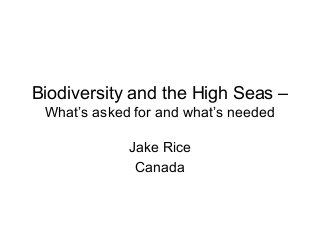
Biodiversity and the High Seas – What’s Asked for and What’s Needed (Rice)
- 1. Biodiversity and the High Seas – What’s asked for and what’s needed Jake Rice Canada
- 2. Three main avenues for creating/expressing needs • UNGA itself – Resolutions to be enacted by other Agencies – Resolutions to be enacted by itself (Parties) • Regulatory / “Oversight” Agencies – Increase sustainability of biodiversity consequences of industries they advise or manage – FAO & RFMOs, IMO, ISA etc • Conservation Agencies – Increase protection / reduce threats to marine and coastal biodiversity – CBD, Ramsar, . IUCN, Regional Seas Conventions(?)
- 3. “Conservation and sustainable use of biodiversity” plays out as the intersections of ecosystem features and human uses Fishing Shipping Mining (etc) Fish population Reality Reality Reality Food Web links Reality … … Habitat feature Reality … … (etc) Reality
- 4. Commonalities among them • For ALL of them, their ultimate mandate and priorities come from UNGA • Goals of the regulatory bodies must be coherent with goals of conservation bodies • Measures adopted by all relevant regulatory bodies must also be coherent for a given ecosystem feature • ALL REQUIRE THE SAME INFORMATION TO USE WITHIN THEIR RESPECTIVE MANDATES
- 5. Rest of presentation: • What are some of the key players trying to achieve? • What support do they need to succeed? • What are the commonalities of necessary support? • Where are the best opportunities for investment?
- 6. CBD (conservation) - Goals • Identify areas and features of the sea that are ecologically and biologically significant – Apply EBSA criteria globally and regionally • Understand the threats to those areas and features – Include biodiversity in mandatory SEAs and IAs • Identify measures that would offer adequate protection to those areas and features – Enable use of multiple tools including Networks of MPAs to achieve conservation and sust. use
- 7. CBD – Information Needs • Application of EBSA criteria – Geo-referenced information on species and habitats that are found in the ocean, and their functional roles – Standards and fora for processes to apply the criteria – A library of the results of expert application of the Criteria to the best available information • Evaluation of threats – Knowledge of direct impacts of human activities on biodiversity features and indirect consequences of direct impacts – Knowledge of expected places and magnitudes of the activities • Provision of adequate management protection – Knowledge of effectiveness of management tools – Wise placement of (spatial) management tools
- 8. FAO (Management) - Goals • Allow fisheries to contribute to economic and social prosperity and food security – Identify sustainable fishing opportunities • Ensure fisheries do not cause serious adverse impacts to vulnerable marine ecosystems – Implement the Deep-Sea Fishery Guidelines: • Identify the areas that meet the VME criteria • Identify mitigation measures that provide adequate protection to VMEs • Conduct adequate impact assessments before authorizing fisheries to proceed • Provide sufficient Management, control and surveillance to prevent Serious Adverse Impacts
- 9. FAO Information needs • Sustainable Fishing Opportunities – Better knowledge of what harvest levels are sustainable – population sizes and life histories • Implement Deep Sea Fishery Guidelines – Geo-referenced information on species and habitats to which to apply the VME criteria – Identification of “best practices” for the: • scientific evaluation tasks in the Guidelines • management practices called for in the Guidelines • impact assessment and risk assessment methodologies required by the Guidelines • Libraries of information & experience with the Guidelines
- 10. UNGA Regular Process - Goals • Policy relevant assessments that integrate ecological, economic, and social information, on global and regional scales, to inform about: – Status and trends (ALL three dimensions) – Opportunities for sustainable development – Needs for greater conservation efforts – Policy gaps – Implementation gaps • The “chapeau” for all the other initiatives
- 11. Regular Process Information Needs • Ecological, economic, and social data sets that have some inter-operability and spatial resolution • Regional and sub-regional assessments of status and trends on all three factors • Sharing and pooling of information and assessments across agencies and jurisdictions • Processes for identifying priorities and needs (conservation AND development) at regional and sub-regional scales • Processes for doing the integration across sectors, social – economic – ecological, and from sub-regional to regional and global
- 12. These have a LOT in common CBD FAO Regular Process Geo-referenced x x x ecological data Information on x x x places and levels of uses Repositories of outcomes x x x Processes for applying criteria x x use results
- 13. These have a LOT in common CBD FAO Regular Process Best practices (X) x User -science steps Best practices (X) x User -management Impact / risk x x x assessments Integrated assessments input input X
- 14. Greater Generality • Points about FAO apply to other IGOs with regulatory or oversight roles: IMO, ISA etc • Points about CBD apply to other cons agencies • UNEP and Regional Seas have agendas & role • IOC and other science orgs can contribute a lot • Regular process will built on everyone else’s products and add much value (and coherence?) • UNGA and BBNJ will keep moving the goalposts – This work will influence type and pace of change,
- 15. Conclusions • Every issue can have “regulatory” agency AND conservation agency engagement • Information needs AND “best practice” standards overlap greatly • Requirement for coherence and efficiency both argue for shared initiatives • Regular process may provide skeleton, but the “meat” will come from agencies • Roles for NGOs in many parts, especially consolidating information and tools.
